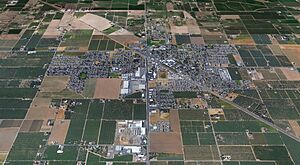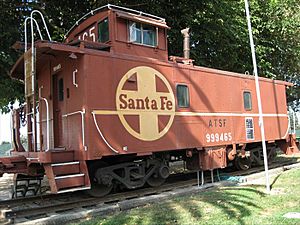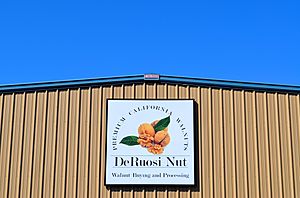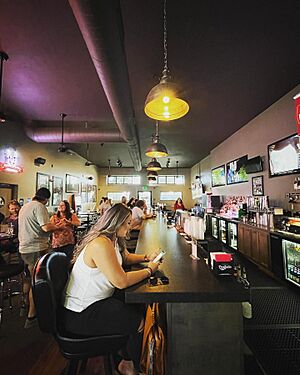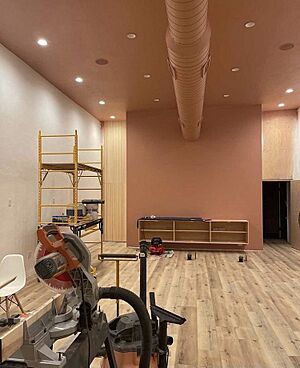Escalon, California facts for kids
Quick facts for kids
Escalon, California
|
||
|---|---|---|
| City of Escalon | ||
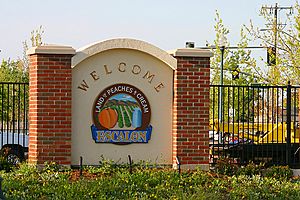
Escalon, Land of Peaches and Cream, welcome sign
|
||
|
||
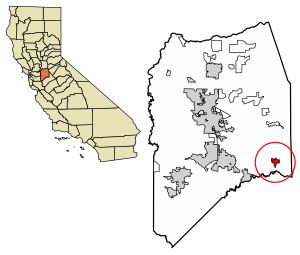
Location of Escalon in San Joaquin County, California
|
||
| Country | ||
| State | ||
| County | San Joaquin | |
| Incorporated | March 12, 1957 | |
| Area | ||
| • Total | 2.35 sq mi (6.08 km2) | |
| • Land | 2.28 sq mi (5.90 km2) | |
| • Water | 0.07 sq mi (0.17 km2) 2.85% | |
| Elevation | 118 ft (36 m) | |
| Population
(2020)
|
||
| • Total | 7,472 | |
| • Density | 3,321.93/sq mi (1,282.85/km2) | |
| Time zone | UTC-8 (PST) | |
| • Summer (DST) | UTC-7 (PDT) | |
| ZIP code |
95320
|
|
| Area code(s) | 209 | |
| FIPS code | 06-22790 | |
| GNIS feature ID | 1656002 | |
Escalon is a city in San Joaquin County, California, United States. The name "Escalon" comes from a Spanish word meaning "stepping stones."
In 2020, about 7,472 people lived in Escalon. This was an increase from 7,132 people in 2010. The city is known for its agricultural roots and friendly community.
Contents
History of Escalon
Escalon began as a farming area. A man named John Wheeler Jones arrived in 1852. He set up his home where Escalon is today. At that time, the land was mostly covered with sagebrush.
John Jones started farming. He planted the first grain in the area. He also raised cattle. Over time, he bought more land. He eventually owned 8,000 acres! In 1867, he built a large brick house. It cost $12,000, which was a lot of money back then.
How Escalon Got Its Name
John Jones's son, James W. Jones, is said to have found the name "Escalon" in a book. He liked the name, which means "stepping stones" in Spanish. He decided to give it to the new town.
Building the Town
In the 1890s, a railroad company planned to build tracks across Jones's land. James W. Jones saw this as a chance to create a town. He hired a surveyor to plan the streets. The streets were laid out diagonally, making some blocks unique shapes.
The first Santa Fe train arrived in Escalon in 1896. This was a big step for the town. It helped connect Escalon to other places. The first post office and store opened soon after.
Early Businesses and Community Life
Many businesses started in Escalon. Nelson Leighton built a large two-story store. It even had the town's first telephone switchboard! Warehouses were built to store grain from the farms.
The Escalon Commercial Club was formed in 1911. This group helped improve the town. They organized events and worked to get better streets. They also helped create the high school.
Education in Escalon
The first school in the area opened in 1878. It was called the Lone Tree school. After Escalon was founded, a new school was built in town.
In 1903, a two-room schoolhouse was built. As more families moved to Escalon, the school grew. In 1914, a bigger building was constructed. It even had an assembly hall for public events.
Escalon Unified School District
In the 1960s, several local school districts decided to join together. This created the Escalon Unified School District in 1967. This district now serves many students in the area.
Schools in Escalon
The Escalon Unified School District includes:
- Escalon High School
- Vista High School (continuation)
- El Portal Middle School
- Dent Elementary School
- Van Allen Elementary School
- Farmington Elementary School
- Collegeville Elementary School
- Escalon Charter Academy
Transportation in Escalon
Escalon is connected to other areas by roads and railways.
Highways and Roads
California State Route 120 passes through Escalon. This highway connects the city to the San Francisco Bay Area and to the Sierra Nevada mountains. McHenry Avenue goes south towards Modesto.
There are plans to improve roads in Escalon. For example, South McHenry Avenue will be widened. A new traffic signal will be added at McHenry and Ullrey avenues.
Railroads
Escalon has two main railway lines. The Union Pacific Railroad operates one line. The BNSF Railway has another line that runs through town. Sometimes, two trains will pass each other, which can cause traffic delays.
The Santa Fe Railway used to offer passenger train service to Escalon. This service ended in 1971.
Geography of Escalon
Escalon is located in San Joaquin County. It has a total area of about 2.4 square miles (6.08 square kilometers). Most of this area is land, with a small amount of water.
Economy and Industry
Escalon's economy is strongly linked to farming. The land around the city is very fertile.
Main Industries
A big part of Escalon's economy comes from processing nuts. Escalon is home to one of the largest walnut processing facilities in the world, called DeRuosi Nut. Other important companies include GoldRiver Orchards and Grower's Choice.
Major Employers
Here are some of the biggest employers in Escalon:
| # | Employer | # of Employees |
|---|---|---|
| 1 | Kraft Heinz (formerly Escalon Premier Brands) | 750 |
| 2 | Hogan Mfg., Inc. | 160 |
| 3 | DeRuosi Nut | 124 |
| 4 | GoldRiver Orchards | |
| 5 | Barton Ranch | |
| 6 | Roche Bros Inc. | |
| 7 | Grower's Choice |
Downtown Escalon
Escalon's downtown area, along Main Street, has always been important. Today, you can find restaurants, a salon, and local family-run businesses there. The Valley Inn, the town's only bar, is one of the oldest bars in California.
Police Department
The Escalon Police Department has 12 full-time employees. They also have volunteers who help out. These volunteers include Police Reserve Officers, Cadets, and Citizen Volunteers.
Sports in Escalon
The Escalon High School sports teams are called the Cougars. They play in the Trans Valley League. The Escalon High Varsity football team has been very successful. They have won five State Championships in the last 30 years!
Football Team Achievements
| Coach | Wins | Losses | Ties |
|---|---|---|---|
| Mark Loureiro (1989-2017) | 282 | 67 | 1 |
| Andrew Beam (2018-) | 50 | 10 | 0 |
| Division III | Division IV | Division V | Division VI | State |
|---|---|---|---|---|
| 2 (1993, 1996) | 6 (1994, 2000, 2002, 2003, 2005, 2010) | 2 (2021, 2022) | 1 (2019) | 5 (1993, 1996, 2010, 2019, 2022) |
Notable People from Escalon
Many interesting people have come from Escalon:
- Rod Beaton – a journalist and media executive.
- Herbert A. Calcaterra – a WWII US Navy sailor. A ship was named after him!
- Alice Estes Davis – a Disney legend and costume designer for Disney films and theme parks.
- James Lew – an American martial arts actor.
- Ted Nuce - a retired professional bull rider and world champion.
Churches in Escalon
Escalon has 14 churches, with 12 located within the city limits. The Escalon Methodist Church was the first church in the area. It was built in 1893 and later moved to Escalon in 1908. A new building for the church was completed in 1921.
Some of the churches in Escalon include:
- Escalon Presbyterian Church
- Escalon Christian Reformed Church
- Escalon Covenant Church
- Trinity Church Assembly of God
- First Baptist Church
- Jackson Avenue Church
- Church of Christ
- Saron Lutheran Church
- United Methodist Church
- Impact Community Church
- Seventh Day Adventist Church
- Pentecostal Tabernacle
- Saint Patrick's Catholic Church
Population Information
| Historical population | |||
|---|---|---|---|
| Census | Pop. | %± | |
| 1960 | 1,763 | — | |
| 1970 | 2,366 | 34.2% | |
| 1980 | 3,127 | 32.2% | |
| 1990 | 4,437 | 41.9% | |
| 2000 | 5,963 | 34.4% | |
| 2010 | 7,132 | 19.6% | |
| 2019 (est.) | 7,574 | 6.2% | |
| U.S. Decennial Census | |||
The 2010 United States Census showed that Escalon had a population of 7,132 people. Most residents were White (81.6%). About 27% of the population identified as Hispanic or Latino.
The census also showed that 99.8% of the people lived in homes. About 39.4% of households had children under 18. The average household size was 2.87 people.
The population's age breakdown was:
- Under 18: 27.1%
- 18 to 24: 9.5%
- 25 to 44: 24.3%
- 45 to 64: 26.6%
- 65 and older: 12.5%
The median age in Escalon was 36.0 years.
See also
 In Spanish: Escalón (California) para niños
In Spanish: Escalón (California) para niños




